
A fortification is a military construction designed for the defense of territories in warfare, and is used to establish rule in a region during peacetime. The term is derived from Latin fortis ("strong") and facere.
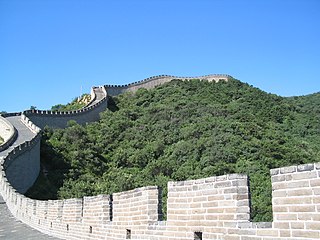
A battlement, in defensive architecture, such as that of city walls or castles, comprises a parapet, in which gaps or indentations, which are often rectangular, occur at intervals to allow for the launch of arrows or other projectiles from within the defences. These gaps are termed embrasures, also known as crenels or crenelles, and a wall or building with them is described as crenellated; alternative older terms are castellated and embattled. The act of adding crenels to a previously unbroken parapet is termed crenellation.

Sigiriya or Sinhagiri is an ancient rock fortress located in the northern Matale District near the town of Dambulla in the Central Province, Sri Lanka. It is a site of historical and archaeological significance that is dominated by a massive column of granite approximately 180 m (590 ft) high.
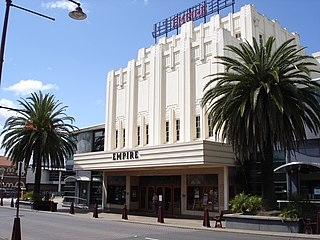
The Empire Theatre is a heritage-listed theatre at 56 & 56A Neil Street, Toowoomba, Toowoomba Region, Queensland, Australia. It was added to the Queensland Heritage Register on 31 May 1994.

Hamilton Central railway station serves Hamilton, South Lanarkshire in Scotland, lying on the Argyle Line. It is situated in the town centre, adjacent to the Hamilton bus station, as well as the Regent Shopping Centre, Hamilton's main shopping location. In March 2007, SPT announced a redevelopment of the bus and railway stations into a combined interchange, which was completed in winter 2012.
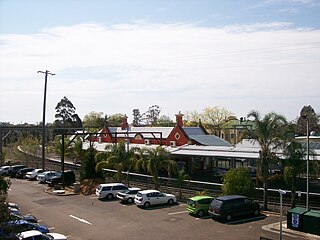
Springwood railway station is a heritage-listed former railway bridge and now railway station located on the Main Western line in Springwood, City of Blue Mountains, New South Wales, Australia. It was designed by NSW Government Railways and built from 1883 to 1884 by John White, Chas. & Wm. Coghill & Thos. Proull. It is also known as Springwood Railway Station Group. The property was added to the New South Wales State Heritage Register on 2 April 1999. The station opened on 11 July 1867. It previously had a passing loop to the east of Platform 1.
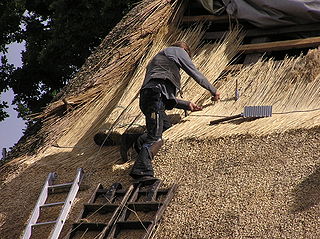
A roofer, roof mechanic, or roofing contractor is a tradesperson who specializes in roof construction. Roofers replace, repair, and install the roofs of buildings, using a variety of materials, including shingles, bitumen, and metal. Roofing work includes the hoisting, storage, application, and removal of roofing materials and equipment, including related insulation, sheet metal, vapor barrier work, and green technologies rooftop jobs such as vegetative roofs, rainwater harvesting systems, and photovoltaic products, such as solar shingles and solar tiles.
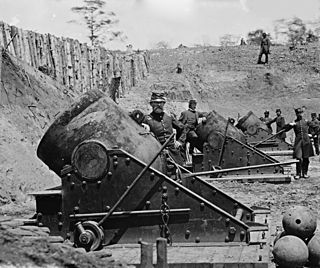
Siege artillery is heavy artillery primarily used in military attacks on fortified positions. At the time of the American Civil War, the U.S. Army classified its artillery into three types, depending on the gun's weight and intended use. Field artillery were light pieces that often traveled with the armies. Siege and garrison artillery were heavy pieces that could be used either in attacking or defending fortified places. Seacoast artillery were the heaviest pieces and were intended to be used in permanent fortifications along the seaboard. They were primarily designed to fire on attacking warships. The distinctions are somewhat arbitrary, as field, siege and garrison, and seacoast artillery were all used in various attacks and defenses of fortifications. This article will focus on the use of heavy artillery in the attack of fortified places during the American Civil War.
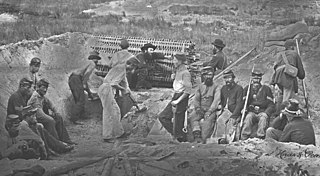
Sapping is a term used in siege operations to describe the digging of a covered trench to approach a besieged place without danger from the enemy's fire. The purpose of the sap is usually to advance a besieging army's position towards an attacked fortification. It is excavated by specialised military units, whose members are often called sappers.

The siege of Ninety Six was a siege in western South Carolina late in the American Revolutionary War. From May 22 to June 18, 1781, Continental Army Major General Nathanael Greene led 1,000 troops in a siege against the 550 Loyalists in the fortified village of Ninety Six, South Carolina. The 28-day siege centered on an earthen fortification known as Star Fort. Despite having more troops, Greene was unsuccessful in taking the town, and was forced to lift the siege when Lord Rawdon approached from Charleston with British troops.

The BP Pedestrian Bridge, or simply BP Bridge, is a girder footbridge in the Loop community area of Chicago, United States. It spans Columbus Drive to connect Maggie Daley Park with Millennium Park, both parts of the larger Grant Park. Designed by Pritzker Prize-winning architect Frank Gehry and structurally engineered by Skidmore, Owings and Merrill, it opened along with the rest of Millennium Park on July 16, 2004. Gehry had been courted by the city to design the bridge and the neighboring Jay Pritzker Pavilion, and eventually agreed to do so after the Pritzker family funded the Pavilion.
Kashyapa I, also known as Kasyapa I or Kassapa I, was a king of Sri Lanka, who ruled the country from 473 to 495 CE. He was the second king of the royal Moriya dynasty of Sri Lanka. Kashyapa is credited with the construction of the Sigiriya citadel and the surrounding city. He acquired the throne by overthrowing his father, King Dhatusena, and usurping his brother and rightful heir to the throne, Moggallana, in a palace coup. He imprisoned and later immured his father. Kashyapa was also known as Pithru Ghathaka Kashyapa, after this incident. He was later defeated by Moggallana, who had fled to South India and returned with an army to regain the throne. Kashyapa was killed in the battle that ensued.

The Suntop Homes, also known under the early name of The Ardmore Experiment, were quadruple residences located in Ardmore, Pennsylvania, and based largely upon the 1935 conceptual Broadacre City model of the minimum houses. The design was commissioned by Otto Tod Mallery of the Tod Company in 1938 in an attempt to set a new standard for the entry-level housing market in the United States and to increase single-family dwelling density in the suburbs. In cooperation with Frank Lloyd Wright, the Tod Company secured a patent for the unique design, intending to sell development rights for Suntops across the country.
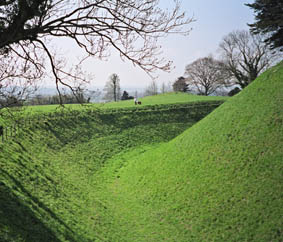
In military engineering, a ditch is an obstacle designed to slow down or break up an attacking force, while a trench is intended to provide cover to the defenders. In military fortifications the side of a ditch farthest from the enemy and closest to the next line of defence is known as the scarp while the side of a ditch closest to the enemy is known as the counterscarp.

A castro is a fortified settlement, usually pre-Roman, some from late Bronze Age and Iron Age, associated with Celtic culture. These are frequently found in Northern Spain, particularly in Asturias, Galicia, Cantabria, Basque Country and the province of Ávila, with the Castro culture and on the plateau with Las Cogotas culture.

Mellors Drapery and Haberdashery is a heritage-listed shop at 28 Capper Street, Gayndah, North Burnett Region, Queensland, Australia. It was built in 1922. It is also known as Overells. It was added to the Queensland Heritage Register on 8 August 1994.

21–23 Lower Fort Street, Millers Point are heritage-listed terrace houses located at 21–23 Lower Fort Street, in the inner city Sydney suburb of Millers Point in the City of Sydney local government area of New South Wales, Australia. It was built from 1832. It is also known as Nicholson's Houses. The property was added to the New South Wales State Heritage Register on 2 April 1999.
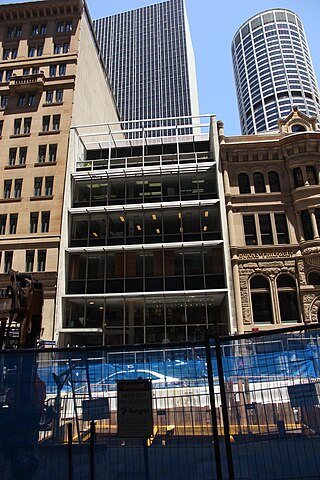
Liner House is a heritage-listed office building located at 13–15 Bridge Street, in the Sydney central business district, in the City of Sydney local government area of New South Wales, Australia. It was designed by Bunning and Madden and built from 1959 to 1960. It is also known as Moran House. It houses a restaurant and the Moran Arts Foundation on its lower floors. It was added to the New South Wales State Heritage Register on 2 April 1999. The building was awarded the Sir John Sulman Medal in 1961.























